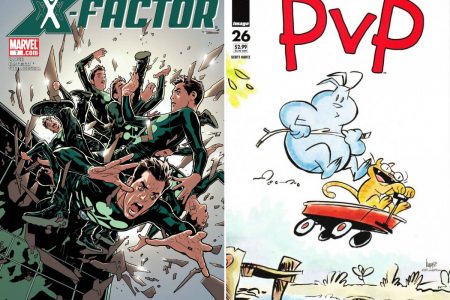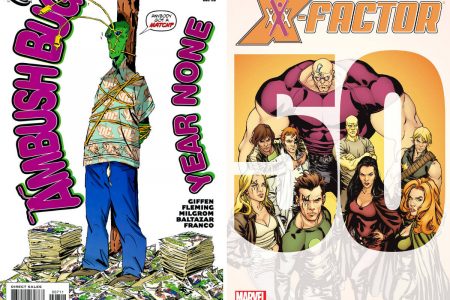Everybody Loves Tank Girl #1–3
Written by Alan Martin
Drawn by Jim Mahfood
Published by Titan Books
Since Tank Girl first appeared in Deadline back in 1988, the visual element of the character and the strips was the main appeal. I have some old Tank Girl comics but I don’t remember much of the stories; it was the art of Jamie Hewlett that sticks in my mind. I think this is one of the reasons that the creative credits on the front cover and on the interior stories has the Mahfood’s name first and Martin’s name second, even though Martin writes the stories. Because the stories here are a strange collection of assorted bits and pieces, nothing resembling a concerted narrative over the three issues, just a collection of fragments that don’t amount to a whole.
For example, there’s a two-pager where Tank Girl cons her boyfriend Booga out of money so she and her friends get a nice meal while he starves; there are splash pages that are like artistic tone poems, with an image accompanied by some strange prose or what feels like a song lyric; there’s a short tale where Tank Girl and Booga kill a lot of people while on LSD (which makes for some trippy visuals, at least), or there’s the short story about the Sixteenth Annual Australian Swearing Competition that is silly (but the swearing doesn’t feel very Australian). There’s a two-page story of crystals talking to each other (which felt like a homage to The Young Ones), a gunfight with the Wee-Wee Brothers (who stand around with their trousers down, urinating), a story where Booga accidentally kills the people hunting him and Tank Girl by urinating from the top of a mountain and the piss icicles created skewer the hunters – I don’t think juvenile covers the level here. Perhaps the most interesting story is Tank Girl 2: The Motion Picture, which does seem to acknowledge the fact that the film was an abysmal piece of rubbish, but then can only manage the suggestion that any adaptation of Tank Girl would be rubbish anyway, even when Tank Girl (and by extension her creators) is responsible.
The book has very strange references: it was written/drawn/published before the Jimmy Saville scandal, because there is the chair from ‘Jock’ll Sort It’ in one strip, which seems completely unexpected now after the fallout from the affair. ‘Frying tonight!!’, a reference to Carry On Screaming! (1966) – how many reading this comic will get that reference? The next reference – ‘And the quarterback is toast!’ – is at least a little more recent (1988’s Die Hard), but it does make you wonder who this comic book is aimed at. There is one main strip that runs through the three issues, about babysitting ‘Feldman Haim’ (named after the two actors with the first name of Corey from The Lost Boys [1987]), and involves the Arty Farty gang. High art this is not. It also ends with the worst sort of ending – effectively, part of it where the kids gets shot in the end was a dream, which is really weak – that makes it even more pointless. It’s fairly juvenile stuff, but not in an fun way (compare and contrast with Evan Dorkin’s Milk and Cheese, for example), and it wants to be edgy and mainstream at the same time (the opening has a Simpsons reference but there are lots of F and C bombs as well, and there is quite a lot of imaginatively drawn beheadings and killing).
The art, which includes black and white pages with some stories in full colour, is the main draw and your enjoyment will depend on how much you enjoy his work. I’ve been a fan of Mahfood since I first saw it in the pages of the Clerks books written by Kevin Smith at Oni Press and then his own Grrl Scouts, with his cartoony style and thick lines infused with his punk-funk/hip-hop sensibility. However, since those days, his work has gotten looser and scratchier and more influenced by graffiti and underground comix, with attention paid equally to the background details and the main action of the characters. Mahfood fills the panels with minutiae that add nothing much to the story but give a sense of the world and the atmosphere he’s trying to attain in his pages, such as the page inside the ‘hippie-fest’ filled with silly little aspects, or he’ll put in the cover to Funkadelic’s Maggot Brain LP for no particular reason. The book also includes Mahfood’s sketches done for the book, and his finished work is quite close to the sketches – the artwork in the book is just as rough and ready as the sketches, which gives the impression of rushed pages despite all the details. But, in the end, the book is for Mahfood and Tank Girl completists only.
Disclosure: this book was provided for review purposes.




